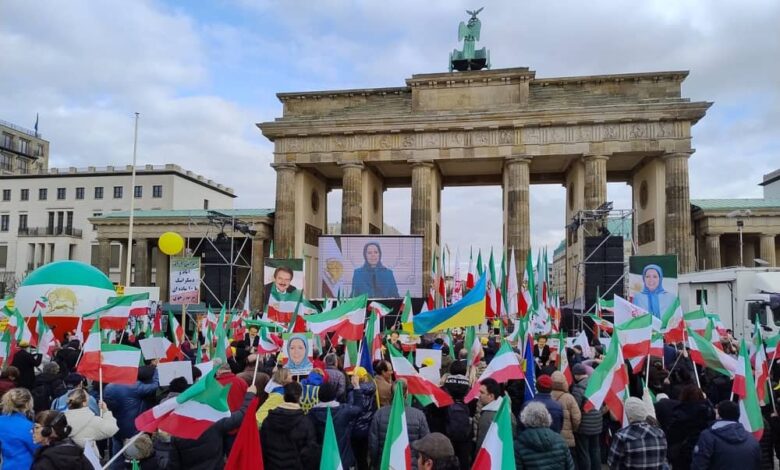Honoring Iran’s 1979 Revolution, an Ongoing Battle Against Two Dictatorships

berlin rally iranian resistance 10022024
Three minutes read
Written by
Farid Mahoutchi
On February 11, Iranians worldwide commemorate the historic 1979 revolution, a pivotal moment in the nation’s history that marked the overthrow of a repressive monarchy. This popular revolution symbolizes the unwavering resolve against tyranny and a fervent desire for freedom and democracy.
The significance of this anniversary cannot be overstated. It serves as a reminder of the Iranian people’s triumph over despotism, discrimination, inequality, and oppression, commemorating the sacrifices made by countless individuals who courageously stood up against injustice.
However, certain Persian media outlets, operating outside of Iran and funded by foreign governments, attempt to diminish the revolution’s significance. They seek to whitewash the crimes of the previous regime and propagate the false idea that Iranians regret their decision to revolt. These outlets conveniently overlook the atrocities committed under the monarchy’s rule and dismiss widespread corruption and class disparities. They even question the historical fact that millions of Iranians rose up against the Shah and ousted his corrupt regime in a nationwide uprising that spanned more than 27 months.
In recent years, these propaganda efforts intensified, especially during the 2022 uprising. Some platforms promoted the son of the former dictator while censoring the main opposition within Iran. Nevertheless, the Iranian people responded with a resounding rejection of these efforts with their slogan: “Death to the oppressor, be it the Shah or the leader (Khamenei).” This slogan crystallized their rejection of deceitful propaganda.
The Iranian people unequivocally reject both the current regime and any return to the former dictatorship. Instead, they aspire to establish a democratic republic. Denying the significance of the anti-monarchy revolution and advocating for a return to monarchy flagrantly disregards principles enshrined in the Universal Declaration of Human Rights and undermines the fundamental right to rebel against oppression.
Advocating for the reinstatement of monarchy has profound implications. Instead of turning back the clock and establishing the rule of a non-existent structure to become the new monarchy, this narrative only seeks to divide the multi-faceted ranks of the opposition and serves the existing theocracy.
Who was Mohammad Reza Pahlavi, Shah, Iran’s Last Pahlavi Dictator?https://t.co/0t7nTCbetQ
— NCRI-FAC (@iran_policy) April 26, 2023
Since 2017, coinciding with the widespread dissemination of the Resistance Units, a domestic network of the People’s Mojahedin Organization of Iran (PMOI/MEK), the occasional protests have become more intense and evolved into nationwide uprisings that threatened the regime’s existence. It is also not a coincidence that the efforts of promoting the mirage of reinstating the deposed monarchy have gained momentum ever since.
In January 2018, days after the bloody crackdown of the uprising, Supreme Leader Ali Khamenei said, “There has been an active involvement of a triangular relationship in these riots. The scheme is orchestrated by the Americans and agents of the Zionist regime. Funds originated from one of these puppet states around the Persian Gulf. However, the stooge was the hypocrite organization, the hypocrites organization that is responsible for human killings. They were the stooges.”
While the involvement of foreign countries in Iran’s nationwide uprising was clearly unfounded, Khamenei made it unequivocally clear to the ruling establishment and his extensive security apparatus that the nature of the regime’s most formidable threat has evolved, signaling a change in approach.
Despite the regime’s severe crackdown, PMOI Resistance Units have played a pivotal role in all major uprisings since, notably by sustaining the momentum of the 2022 uprising. Even today, they persist in fueling the flames of resistance.
Hence, Khamenei’s regime emerges as the sole beneficiary in preventing the world and Iranian society from learning about these units. By silencing and discrediting the PMOI, the regime aims to deprive the oppressed nation of the hope that change is achievable.
Moreover, the idea of returning to a monarchical dictatorship only serves the interests of the current regime. Any propaganda promoting such regression perpetuates the regime’s existence by diverting attention from its failures and atrocities.
Through its channels within foreign-based Persian language media, the regime adeptly engages in a sophisticated strategy. Despite claiming to oppose the regime, these narratives distort historical facts surrounding the overthrow of the Shah and misrepresent a significant revolution as a mistake that resulted in a worse nightmare. Consequently, these narratives do not foster a sentiment conducive to another revolution and regime change; instead, they undermine any inclination to rise up and combat tyranny.
By neutralizing the PMOI, the regime aims to eliminate any viable alternative, such as the National Council of Resistance of Iran (NCRI), which includes the organization as a part of its structure. Without a credible opposition that connects domestic revolution with an internationally recognized political umbrella, the regime believes its continued existence is assured.
As progress is forged through struggle and sacrifice, rather than regressing and remorse, Iranians commemorate the anniversary of the 1979 revolution, reaffirming their dedication to the principles of freedom, justice, and democracy. Rather than accepting a choice between the lesser of two evils, they hold themselves deserving of the highest ideals. The Iranian people aspire to construct a democratic republic where their rights and freedoms are upheld. The journey towards this objective entails organized resistance and the unwavering endeavors of dedicated individuals such as the PMOI Resistance Units.

